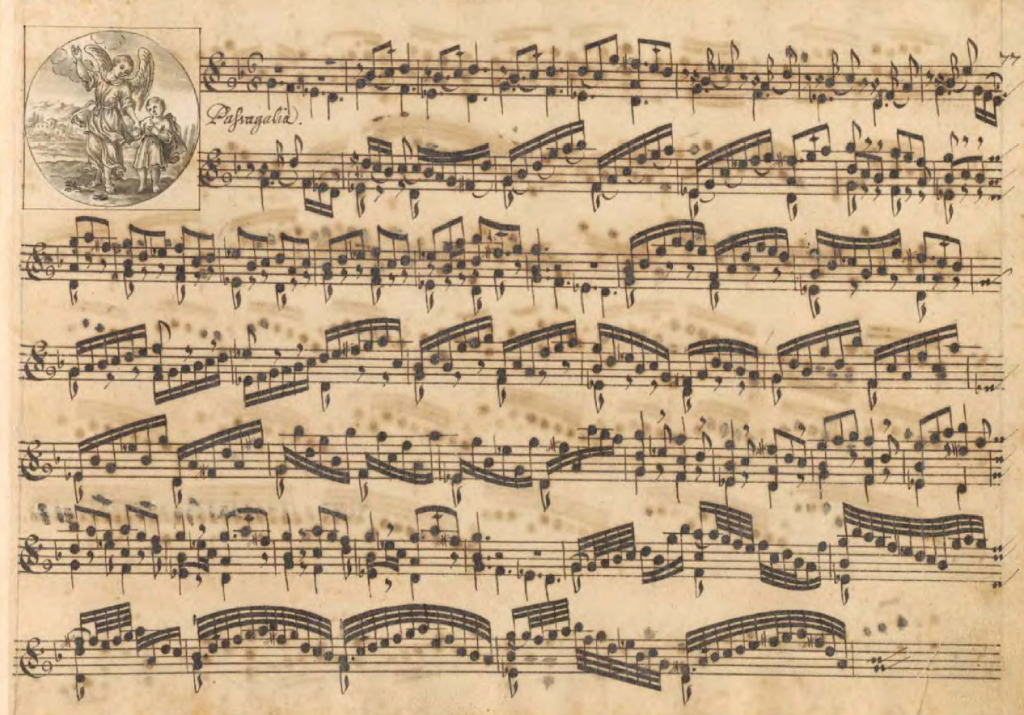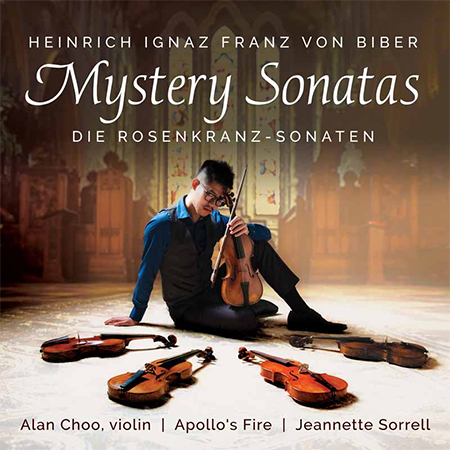by Daniel Hathaway

Probably written in the 1670s, but unknown to modern ears until first published in 1905, the devotional work is preserved in a beautiful manuscript held in the Bavarian State Library in Munich.
Four Apollo’s Fire violinists presented eight of the sonatas on programs in January 2019. And Alan Choo soloed in a pair of them on a set of programs in January 2023 as part of a multi-season project to record all fifteen sonatas plus the Passacaglia that concludes the meditations. The resulting CD, Biber’s Sacred Mysteries, has just been released, and will be available for purchase at Apollo’s Fire’s four concerts this week, when Choo will be featured in seven of the sonatas.
In a recent Zoom conversation from Seoul, where the Singaporean violinist and Apollo’s Fire concertmaster was making a stopover enroute to Cleveland, Choo said, “This time the whole program is based on the Mystery Sonatas, but we’re not doing all of them because all 16 in one sitting would probably be quite a bit too long. Also, that would mean that I’d ideally need 15 different violins, which is a little bit impractical. So we are going to perform 7 of them and some other pieces in between that feature the continuo instruments. We have quite a colorful continuo team, so I thought it would be nice if there were moments where we could hear some solos, including a harpsichord piece that Jeannette Sorrell is going to play.”
Fifteen different violins? That’s because one of the prominent features of Biber’s magnum opus is that while the first and last sonatas are designed to be played on a violin with standard tuning in fifths (G-D-A-E), the middle thirteen require that its four strings be tuned to a variety of different pitches, a technique known as scordatura, changing the color and emotional affect of the sound. (Karina Schmitz, Adriane Post, Johanna Novom, and Carrie Krause, the soloists in 2019, discussed this in detail in our preview article.)

And how about those multiple fiddles? “I’m borrowing them from some friends and other violinists in the area. Also, I’m traveling with an extra violin that a friend lent me, and I have a spare violin over in Cleveland as well. I think for this program I’ll just need six because I can use the same violin for the first and last sonatas, which is a relief. But for the other pieces, it’s better if I have separate violins that are just kept to those tunings. That just makes everything more stable.”
For Choo, the composer’s skills go well beyond tuning systems. “Biber is such a master at conveying storytelling and effects, and that is apparent not just in the tuning, but also in his compositional techniques. For example in the opening sonata, ‘The Annunciation,’ the first two pages are so attention-grabbing. It’s written in the fantastical style, which means that it’s like flights of fancy for the violin, and there’s this sense of ecstasy, awe, and wonder at the news that she’s going to be impregnated with the son of God. If you really have the story and the emotions and the images at the forefront of your mind all the time, the notes really leap off the page, and it becomes something that is beyond just technical.”
I suggested that for the listener there are a number of doors to come through to appreciate this repertoire. One is Catholic mysticism. “I did quite a bit of research into the stories and some details surrounding what was written in the Bible about each of these 15 mysteries,” Choo said. “The final Passacaglia, number 16, is not technically part of the Rosaries. It’s kind of like an epilogue to all that has happened. And the only clue to what it depicts is in the beginning engraving, where an angel is leading a child by the hand.
“This is one of the first pieces that I really wanted to play when I first started playing Baroque violin because it’s just the most gorgeous thing ever and I fell in love with it. Every time I’ve played it, it has taken on new meanings for me. It kind of brings us back into the mortal realm after the Assumption and the Coronation of Mary. And there’s something about the cyclical ground bass, that keeps going round and round, that’s like a guardian angel that will never leave you until the end of time. I think that’s something really beautiful.
“Even the main Rosary sonatas are storytelling pieces. But unlike, for example, Vivaldi’s Four Seasons, where every single motif has some words describing what it represents, for the Rosary Sonatas, you’re just given the context of what mystery it is depicting. There’s a lot more interpretational freedom that you can bring into these pieces, because not everything is spelled out so clearly. It was quite a fun part of the process talking with my continuo players to ask, ‘Hey, what do you think this part is depicting, and if it’s depicting this, how shall we orchestrate our instrumentation to reflect the kind of mood that we want?’ Artistically it’s been quite a journey and I can’t wait to share our interpretation with everyone. It’s going to be quite wonderful to hear, I think.”
Who is on Choo’s continuo team? “There’s of course Jeannette playing harpsichord, there’s Peter Bennett on the organ, there’s René Schiffer on cello, Billy Simms and Brian Kay on the plucked lutes, and Anna O’Connor on harp. And finally, a very special bowed instrument, the lirone, is going to be played by Kivie Cahn-Lipman, one of our cellists. It’s quite a special instrument. All it can do is play chords, but it plays them in the most beautiful way ever. It has a very flat bridge and many strings, so you can play multiple strings at the same time. It just sustains the triad, and it’s a really special sound.
“There are some albums that perhaps use fewer continuo instruments, but since we have access to a wide variety of colors, we thought it’d be fun to explore that, and we’ve been quite pleased with the result, I must say.”
I suggested that in a way, the Biber sonatas are like a Baroque Pictures at an Exhibition in which the listener wanders thoughtfully through a gallery of images. “I’ve never drawn that link before,” Choo said, “but I think you’re completely right. Apparently there’s a tradition of walking the Rosary, like making the Stations of the Cross. These are like meditations in front of each of the paintings, if you will.
“I’m proud of the recording that we have done,” Choo said. “I think it’s really nice to listen to it in the comfort of your own home, or maybe while driving. But at the end of the day, nothing beats live performance. I think it’s quite a different experience for audiences to come and listen to these pieces live because they’re so dynamic. I’m honestly never doing the same thing twice with this kind of music. Your sense of timing, the tempos that you take, the rubato, the ornaments — there’s such a strong improvisational element to it, which is what defines this 17th-century fantastical style. There’s always something different and something exciting in the live experience.”
Apollo’s Fire presents “Sacred Mysteries: Biber’s Rosary Sonatas for Violin” featuring Alan Choo, beginning on Thursday, February 15 at 7:30 at West Shore Unitarian Universalist Church in Rocky River, repeated on Friday at 7:30 and Saturday at 8:00 at St. Paul’s in Cleveland Hts., and Monday at 7:30 at First Methodist in Akron. Pre-concert conversation with visiting scholar Susan McClary one hour before the performance. Afterglow event following the concert: a CD release party celebrating Choo’s new album. Tickets available online.
Published on ClevelandClassical.com February 12, 2024.
Click here for a printable copy of this article





